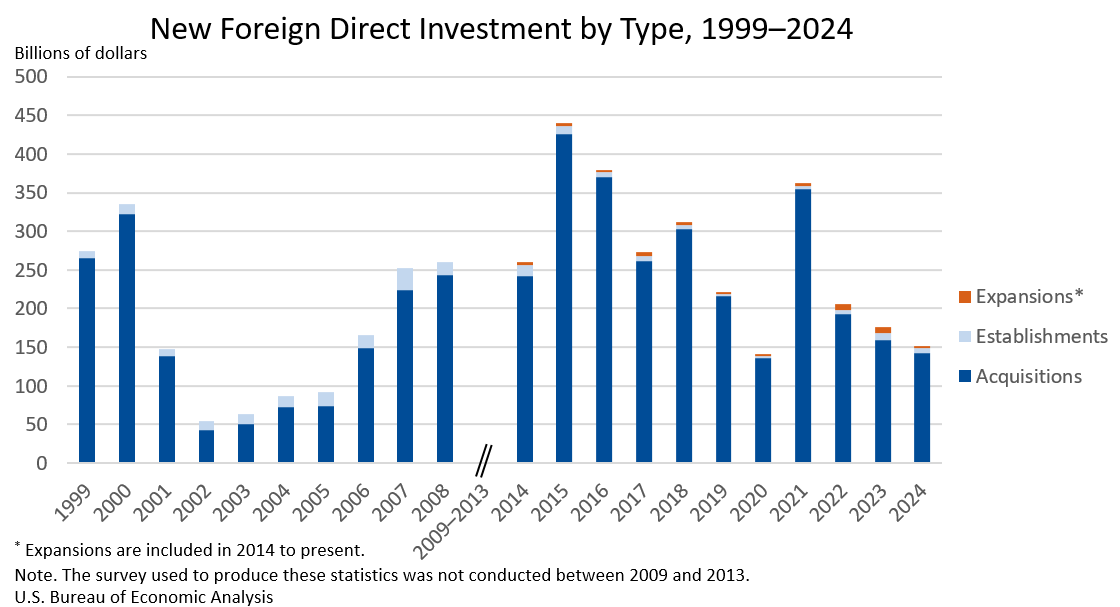Bureau of Economic Analysis
New Foreign Direct Investment in the United States, 2024
Expenditures by foreign direct investors to acquire, establish, or expand U.S. businesses totaled $151.0 billion in 2024, according to preliminary statistics released today by the U.S. Bureau of Economic Analysis. Expenditures decreased $24.9 billion, or 14.2 percent, from $176.0 billion (revised) in 2023 and were below the annual average of $277.2 billion for 2014–2023. As in previous years, acquisitions of existing U.S. businesses accounted for most of the expenditures.
Principal Federal Economic Indicators
Noteworthy
- 2025 News Release Schedule
- Innovation at BEA
- 2025 Annual Updates
- New! Services Trade Data for More Countries
- Data Tool: Trade in Value Added
- Distribution of State Personal Income
- Updated: RIMS II Regional Multipliers
- Arts and Culture
- Space Economy
- FDI Now in State BEARFACTS
- Quick Guide: Price Indexes
The Latest
Gross Domestic Product, 3rd quarter 2014 (second estimate); Corporate Profits, 3rd quarter 2014 (preliminary estimate)
Real gross domestic product -- the value of the production of goods and services in the United States, adjusted for price changes -- increased at an annual rate of 3.9 percent in the third quarter of 2014, according to the "second" estimate released by the Bureau of Economic Analysis. In the second quarter, real GDP increased 4.6 percent. The GDP estimate released today is based on more complete source data than were available…
BEA is Launching the Survey of New Foreign Direct Investment (BE-13)!
The BE-13 survey captures information about new investments made when a foreign investor establishes or acquires a U.S. business (either directly, or indirectly through a U.S. business it already owns) or expands an existing U.S. business.
The data collected in the survey will help in assessing the impact of foreign direct investment on the U.S. economy, in advising foreign investors seeking to invest in the United States, and in…
Activities of U.S. Affiliates of Foreign Multinational Enterprises in 2012
The Bureau of Economic Analysis (BEA) has released preliminary statistics on the activities of U.S. affiliates of foreign multinational enterprises (MNEs) in 2012. These statistics are based on the results of the 2012 Benchmark Survey of Foreign Direct Investment in the United States (“inward” direct investment.)
These statistics cover the finances and operations of U.S. affiliates of foreign MNEs—including balance sheet and income…
Local Area Personal Income: 2013
Personal income grew in 2013 in 2,695 counties, fell in 390, and was unchanged in 28. On average, personal income rose 2.0 percent in 2013 in the metropolitan portion of the United States and rose 2.1 percent in the nonmetropolitan portion. The metropolitan and nonmetropolitan portions grew 5.3 percent and 4.4 percent, respectively, in 2012. The percent change from 2012 to 2013 in personal income ranged from -35.0 percent in Lamoure County,…
Local Area Personal Income, 2011-2013
Personal income grew in 2013 in 2,695 counties, fell in 390, and was unchanged in 28, according to estimates released today by the U.S. Bureau of Economic Analysis. On average, personal income rose 2.0 percent in 2013 in the metropolitan portion of the United States and rose 2.1 percent in the nonmetropolitan portion. The metropolitan and nonmetropolitan portions grew 5.3 percent and 4.4 percent, respectively, in 2012.
Guam's Economy Grew 0.6 Percent in 2013
Newly published estimates of gross domestic product for Guam show that real GDP – GDP adjusted to remove price changes – increased 0.6 percent in 2013.
New BEA Data Provide Entrepreneurs with a Fortune 500 Research Department
Is consumer spending growing faster in North Dakota or North Carolina? How do consumers in different regions respond to economic downturns? Which state has the fastest growing consumer market for motor vehicles?
Gross Domestic Product for the Commonwealth of the Northern Mariana Islands (CNMI), 2013
This release is available as a PDF download.
Widespread Industry Growth Drives Upturn in GDP in Second Quarter
Widespread industry growth drove the U.S. economy’s second-quarter rebound, with 19 of the 22 industry groups tracked contributing 6.7 percentage points to real Gross Domestic Product. Finance, insurance, real estate, rental and leasing; manufacturing; and agriculture, forestry, fishing and hunting led the way.
Real GDP increased 4.6 percent in the second quarter, after decreasing 2.1 percent in the first quarter.




